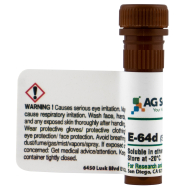Alzheimer's disease is characterized by accumulation of a variety of amyloid beta (Aβ) peptides as oligomers (twisted tangles of protein) and amyloid plaques (abnormal clusters of protein fragments) in the brain. These are factors involved in neuronal loss and memory deficits over time. The neurotoxic Aβ peptides are created when enzymes cleave a large protein called amyloid precursor protein (APP) into smaller Aβ peptides of varying toxicity. N-truncated pyroglutamate-AB (pGlu-Ab) has been shown to be among the most neurotoxic form of the Aβ peptides.
Alzheimer's disease is characterized by accumulation of a variety of amyloid beta (Aβ) peptides as oligomers (twisted tangles of protein) and amyloid plaques (abnormal clusters of protein fragments) in the brain. These are factors involved in neuronal loss and memory deficits over time. The neurotoxic Aβ peptides are created when enzymes cleave a large protein called amyloid precursor protein (APP) into smaller Aβ peptides of varying toxicity. N-truncated pyroglutamate-AB (pGlu-Ab) has been shown to be among the most neurotoxic form of the Aβ peptides. Cathepsin B Reduction
Reducing the concentration of cathepsin B using an enzyme inhibitor prevents the creation of the neurotoxic peptide, pGlu-Ab, which has been linked to the development of Alzheimer's disease. The candidate inhibitor drug, a cysteine protease inhibitor named E-64D, was developed by scientists from the University of California, San Diego School of Medicine, the Medical University of South Carolina, and San Diego-based American Life Science Pharmaceuticals, and has already been shown to be safe in humans. Currently, research using mouse models of Alzheimer's has been reported in the Journal of Alzheimer's Disease.
Current drugs for Alzheimer's treat a few symptoms of the devastating neurological disorder, but none actually slow its progress, nor are there preventative effects or cures. A decade has passed since the approval of the last Alzheimer's drug. No other therapeutic program is investigating cysteine protease inhibitors for treating Alzheimer's, said Vivian Hook, the papers lead author. The researchers focused on cathepsin B production of N-truncated pGlu-Ab, a peptide or short chain of amino acids, and the blockade of cathepsin B by E-64D, a compound shown to inhibit cysteine proteases, a type of enzyme.
Many Alzheimer's research has focused on the amyloid precursor protein (APP)-cutting enzyme BACE1 beta-secretase, but its role in producing pGlu-Ab was unknown at the time. Cathepsin B is an alternative beta-secretase which cleaves the wild-type beta-secretase site of APP, which is expressed in the major sporadic and many familial forms of Alzheimer's. Hook and colleagues looked at what happened after gene knockout of BACE1 or cathepsin B. They found that cathepsin B, but not BACE1, produced the highly toxic pGlu-Aβ.
Cathepsin B Reduction
Reducing the concentration of cathepsin B using an enzyme inhibitor prevents the creation of the neurotoxic peptide, pGlu-Ab, which has been linked to the development of Alzheimer's disease. The candidate inhibitor drug, a cysteine protease inhibitor named E-64D, was developed by scientists from the University of California, San Diego School of Medicine, the Medical University of South Carolina, and San Diego-based American Life Science Pharmaceuticals, and has already been shown to be safe in humans. Currently, research using mouse models of Alzheimer's has been reported in the Journal of Alzheimer's Disease.
Current drugs for Alzheimer's treat a few symptoms of the devastating neurological disorder, but none actually slow its progress, nor are there preventative effects or cures. A decade has passed since the approval of the last Alzheimer's drug. No other therapeutic program is investigating cysteine protease inhibitors for treating Alzheimer's, said Vivian Hook, the papers lead author. The researchers focused on cathepsin B production of N-truncated pGlu-Ab, a peptide or short chain of amino acids, and the blockade of cathepsin B by E-64D, a compound shown to inhibit cysteine proteases, a type of enzyme.
Many Alzheimer's research has focused on the amyloid precursor protein (APP)-cutting enzyme BACE1 beta-secretase, but its role in producing pGlu-Ab was unknown at the time. Cathepsin B is an alternative beta-secretase which cleaves the wild-type beta-secretase site of APP, which is expressed in the major sporadic and many familial forms of Alzheimer's. Hook and colleagues looked at what happened after gene knockout of BACE1 or cathepsin B. They found that cathepsin B, but not BACE1, produced the highly toxic pGlu-Aβ.
 Inhibiting Cathepsin B with E-64D
The scientists found that E-64D, an enzyme inhibitor of cathepsin B, reduced production of pGlu-AB and other Alzheimer's-associated AB peptides. The key finding that E-64D and cathepsin B gene knock out resulted in improved memory deficits in a mouse model of Alzheimer's. This is an exciting finding, said Hook. It addresses a new target cathepsin B and an effective, safe small molecule, E-64D, to reduce the pGlu-AB that initiates development of the disease's neurotoxicity. No other work in the field has addressed protease inhibition for reducing pGlu-AB of Alzheimer's.
Current Research on E-64D
E-64D has already been shown to be safe in clinical trials for patients with muscular dystrophy and would, therefore, likely prove safe for treating Alzheimer's as well. Hook hopes to launch Phase 1 human clinical trials in the near future with a modified version of the drug candidate.
Related:
Inhibiting Cathepsin B with E-64D
The scientists found that E-64D, an enzyme inhibitor of cathepsin B, reduced production of pGlu-AB and other Alzheimer's-associated AB peptides. The key finding that E-64D and cathepsin B gene knock out resulted in improved memory deficits in a mouse model of Alzheimer's. This is an exciting finding, said Hook. It addresses a new target cathepsin B and an effective, safe small molecule, E-64D, to reduce the pGlu-AB that initiates development of the disease's neurotoxicity. No other work in the field has addressed protease inhibition for reducing pGlu-AB of Alzheimer's.
Current Research on E-64D
E-64D has already been shown to be safe in clinical trials for patients with muscular dystrophy and would, therefore, likely prove safe for treating Alzheimer's as well. Hook hopes to launch Phase 1 human clinical trials in the near future with a modified version of the drug candidate.
Related:
